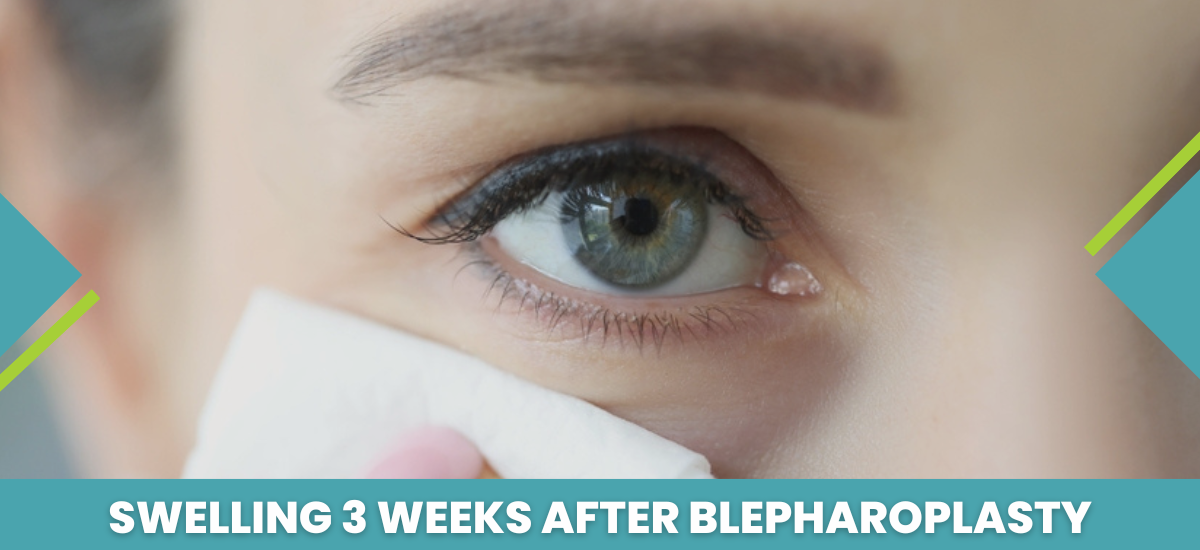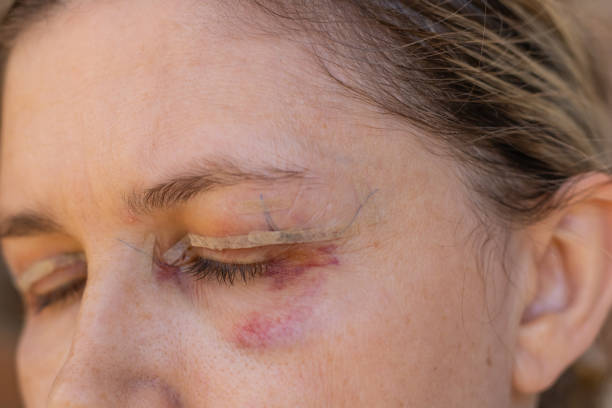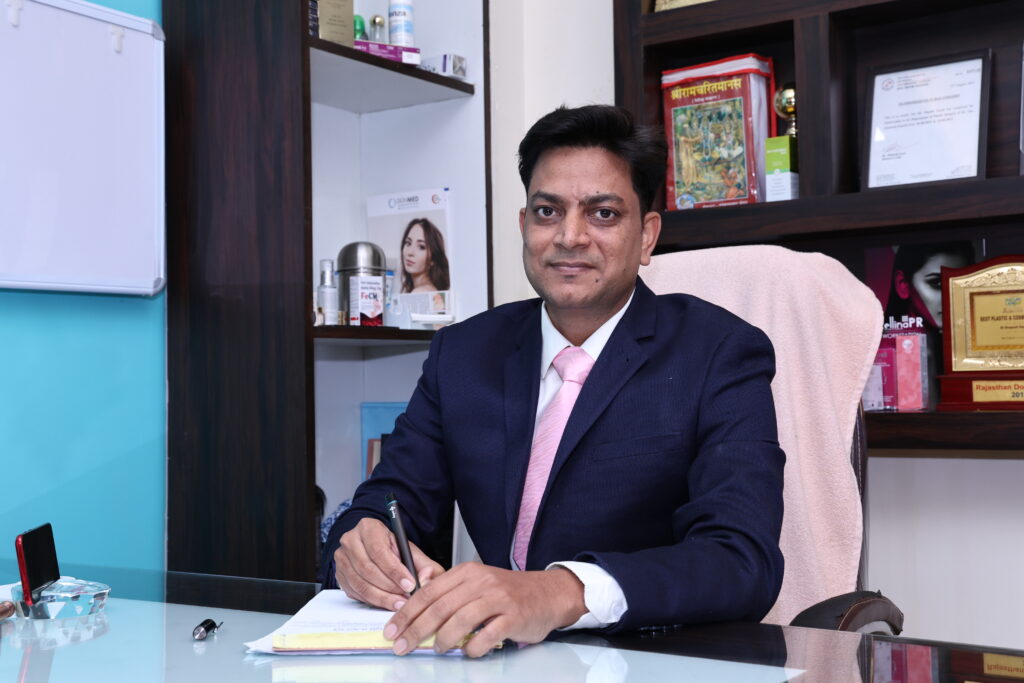
Blepharoplasty, also known as eyelid surgery, is a popular cosmetic procedure designed to rejuvenate tired-looking eyes by removing excess skin, fat, and muscle. While the results can be life-changing, the recovery process requires patience—especially when swelling becomes a lingering concern.
If you are experiencing swelling 3 weeks after blepharoplasty, you are not alone. Many patients at Rejuvena Cosmo Care, a trusted plastic surgery clinic in Jaipur, report similar symptoms during this recovery window. But how do you know if it is part of the normal healing cycle or something to worry about?
Let’s explore what’s expected, what’s not, and how to manage persistent swelling effectively.
Are you worried about the swelling? Read on to find out if it’s normal or not.
Is Swelling Normal 3 Weeks After Blepharoplasty?

Yes—swelling after blepharoplasty can persist up to several weeks post-surgery. In fact, some mild to moderate puffiness at the 3-week mark is quite usual, especially if you have undergone both upper and lower eyelid surgery. However, the nature and severity of the swelling can vary based on individual healing factors, surgical technique, and post-op care.
Dr. Deepesh Goyal, an acclaimed plastic surgeon in Jaipur, often reassures patients that while early swelling diminishes quickly, residual puffiness may linger up to six weeks or even longer.
But remember the swelling should be gradually improving—not worsening.
Concerned about prolonged swelling? Book an assessment with a board-certified plastic surgeon today.
Let’s understand the timeline so you know what to expect.
Stages of Swelling After Eyelid Surgery
Understanding the blepharoplasty swelling recovery process can help set realistic expectations and reduce anxiety. Here’s a general breakdown:
Week 1:
- Immediate swelling and bruising.
- Eyes may feel tight or sore.
- Cold compresses and head elevation are crucial.
Week 2:
- Bruising starts to fade.
- Swelling begins to decrease but may still be noticeable.
Week 3:
- Lingering puffiness, especially in the mornings.
- Most people feel confident enough to resume social activities with light makeup.
Weeks 4–6:
- Swelling continues to subside.
- The final shape of the eyelid area becomes clearer.
After 6 Weeks:
- Minimal swelling should remain.
- Full results begin to show.
If you are at week 3 and experiencing after blepharoplasty swelling, this falls within the general healing window—as long as the swelling isn’t worsening or accompanied by pain or discharge.
Now, let’s check out the reasons for swelling.
Possible Causes of Swelling 3 Weeks After Blepharoplasty

Several factors could be contributing to persistent swelling at this stage:
Fluid Retention
Postoperative swelling can stem from the body’s natural response to trauma. Fluid may accumulate in the eyelid tissues, especially when lying flat.
Increased Physical Activity
Have you recently returned to exercise? Even light workouts can increase blood flow to healing tissues, causing temporary puffiness.Allergic Reactions
Eye creams, ointments, or even makeup introduced too early can irritate healing skin, leading to inflammation.Sleeping Position
Sleeping without elevating your head can allow fluids to pool around the eyes, increasing morning puffiness.Infection or Hematoma (Rare)
In rare cases, swelling may be a sign of infection or a small internal bleed. These would typically be accompanied by redness, warmth, or pain.What are the red flags that you should be aware of?
When to Be Concerned About Swelling

While swelling 3 weeks after blepharoplasty is often harmless, you should stay alert to signs that may indicate a complication:
-
- Swelling that’s suddenly increasing
- Accompanied by sharp pain, redness, or heat
- Pus or yellow discharge from the incision sites
- Fever or flu-like symptoms
- Vision disturbances, like blurriness or double vision
If any of these occur, contact your surgeon immediately. Early intervention can prevent more serious issues and ensure smoother healing.
Looking for ways to speed up the recovery process?
Tips to Reduce Swelling and Speed Up Healing

You can take several steps to reduce swelling after blepharoplasty and promote recovery.
Continue cold compresses (if advised)
Although most effective in the first week, some patients find gentle cooling helpful even at week 3.Sleep with head elevated
Use an extra pillow or wedge to encourage drainage and reduce morning puffiness.
Stay hydrated
Water helps flush toxins and supports tissue repair.Eat an anti-inflammatory diet
Include foods rich in omega-3s, vitamins C & E, and antioxidants. Avoid salty or processed foods that cause water retention.Avoid strenuous activity
Stick to gentle walks and light movement. Avoid bending or lifting.Gentle lymphatic drainage massage
Only if cleared by your surgeon—this can help drain excess fluid and reduce tightness.Avoid alcohol and smoking
Both slow healing and contribute to inflammation.Better safe than sorry—know when it’s time to make that call.
When to Contact Your Surgeon
If your swelling is persistent, worsening, or accompanied by other symptoms like pain or discharge, don’t hesitate to reach out. At Rejuvena Cosmo Care, we always encourage patients to check in if anything feels off.
Dr. Deepesh Goyal, known for his personalized care approach, often reminds patients that no concern is too small during recovery. Even reassurance can be part of healing.
Wrapping up
Experiencing swelling 3 weeks after blepharoplasty is usually part of the normal healing journey. But knowing what is normal—and what’s not—can help you navigate recovery with confidence.
Most cases improve with time, care, and patience. Still, never hesitate to reach out to your surgeon if something doesn’t feel right. With proper support and post-op guidance, you will be back to feeling and looking your best in no time.
Frequently Asked Questions
How long does swelling last after blepharoplasty?
Swelling typically peaks within the first 2–3 days, then gradually subsides. However, minor swelling can persist for 4–6 weeks or longer, especially in the mornings.
Is swelling normal 3 weeks after lower eyelid surgery?
Yes, it’s normal—especially in lower eyelid procedures where healing may take a bit longer due to tissue sensitivity.
Can I wear makeup 3 weeks after blepharoplasty?
If your incisions have healed and your surgeon has cleared it, light makeup may be safe. Always use clean, hypoallergenic products.
What if my swelling suddenly worsens at week 3?
Sudden swelling may be a sign of infection or hematoma. Contact your surgeon immediately if it’s paired with pain, redness, or discharge.
How can I reduce swelling after blepharoplasty at home?
Elevate your head while sleeping, apply cold compresses, stay hydrated, and avoid strenuous activities. Eating anti-inflammatory foods can also help.

